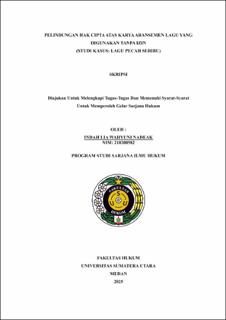| dc.description.abstract | This study aims to analyze the legal protection of arrangers in a regulation that protects the copyright of songs or music that have been rearranged by the arranger but used by other parties without permission. In the case study of the song "Pecah Seribu," this study requires research with informants to determine the effectiveness of copyright regulations on arrangers as parties whose rights should be protected for the song arrangements they have created. The research method used in this thesis is a normative empirical study that examines law as a rule or norm and the application of legal rules in practice in society through interviews with relevant informants to obtain synchronous data between the regulation and its actual application. Regulations regarding music arrangements are regulated by Law Number 28 of 2014 concerning Copyright, Article 40 paragraph (1) letter n and Article 40 paragraph (2), and explicitly stipulated in Article 2 paragraph (3) of the Berne Convention. Under the Copyright Law, an arranger's position is implicitly categorized as a Creator, but is limited to arrangements they create outside of the original work. Based on the case study of the song "Pecah Seribu," the unauthorized use of the arranger's arrangement violates the arranger's economic rights as the creator, including the publication of the work, performance of the work, duplication of the work, distribution of the work, and the creator's moral rights. Violations of the arranger's rights as the creator of song arrangements are commonplace and are simply ignored without resolution, which actually harms the arranger as the creator. This occurs due to a lack of public awareness of the importance of copyright protection for one's work and a lack of attention to small music industry players, such as arrangers, who in reality have the right to protect their arranged works if used by others without permission and to the arranger's detriment, thus creating legal uncertainty. | en_US |


